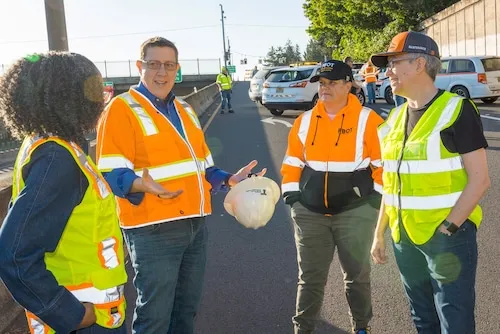In a state known for its stunning landscapes and environmental zeal, Oregon faces a transport crisis, one that poses significant challenges for its Department of Transportation (ODOT). The agency’s managers recently took the unprecedented step of publicly sharing their struggles with internal communication and trust between agency leaders and staff. This transparency reveals deeper fissures within the state’s transportation forum, raising questions about how funds are allocated, infrastructure is managed, and the overall state of transportation policy moving forward.
The transportation debate in Oregon, often overshadowed by climate initiatives and social equity discussions, is now receiving the attention it deserves. With rising concerns about climate change, crumbling infrastructure, and economic impacts from disruptions in freight and public transport, understanding this complex issue is more vital than ever. Adding to this urgent situation is the interplay between partisan agendas, which threatens to skew essential funding initiatives.
Ambiguity and Mistrust: The ODOT Experience
In a recent meeting, ODOT managers aired grievances regarding a lack of clear communication from the agency’s leaders, which they described as leaving them ‘in the dark’ about critical decisions affecting their ability to perform their jobs effectively. Multiple managers indicated that trust has eroded, complicating the already intricate work environment they operate in, particularly as they strive to address upcoming infrastructure requirements and safety standards.
This situation is complicated by the political context in which ODOT operates. With transportation being a high-stakes game where every decision can be scrutinized by interest groups and politicians alike, a lack of internal clarity can lead to external consequences. Funds earmarked for infrastructure improvements can easily be delayed or misallocated due to a diluted focus resulting from poor communication.
The Role of Leadership in Transportation Policy
Leadership within ODOT must recognize the crucial role they play in steering the organization towards its objectives. A collaborative approach, one that fosters open lines of communication with all staff, will empower managers and ensure better decision-making overall. This leadership gap has alarming ramifications—managers struggle to prioritize projects or understand the funding landscape, leading to ineffective uses of limited resources.
At a time when ODOT grapples with pressing issues—such as climate resilience, urbanization, and public safety—the agency’s leadership must pivot towards inclusive strategies. It includes embracing input from managers and being receptive to their insights. Responsible leadership goes beyond mere oversight; it is about engaging every level of the organization in crafting sustainable, long-term approaches to transportation challenges.
High-Stakes Debate: Funding and Partisanship
The current turmoil within ODOT aligns closely with broader statewide discussions about transportation funding, which have turned increasingly partisan. The pivotal question remains: will Oregon’s highway finance succumb to political squabbles, or can bipartisan efforts prevail for the greater good?
For many years, transportation funding has been a hot-button issue marked by partisan divides on how best to allocate scarce resources. Voters are faced with a barrage of proposals and initiatives that seek to address congestion, safety, climate change, and equity. The influence of powerful lobbying groups only furthers this divide, making it increasingly crucial for government officials to engage in a more holistic, inclusive approach to tackling transportation policy.
Those within ODOT who are advocating for a unified message recognize that partisan measures through funding are counterproductive. Everyone on both sides of the aisle aims to build a better transportation system. Thus, finding common ground should be prioritized over assigning blame or pointing fingers.
Public Perception and Stakeholder Engagement
As Oregon’s residents witness the mounting concerns about their transportation network, public perception is an essential factor. Trust in ODOT directly impacts the ability of the agency to realize its goals. Transparency about internal struggles can help rebuild faith, but proactive communication with stakeholders—such as community organizations and advocacy groups—will prove beneficial for tightening working relationships.
Public opinion often sways decisions made at the governmental level, compelling officials to act effectively and efficiently. Engaging local communities, empowering grassroots organizations, and working alongside advocacy groups in the realms of transportation planning can open up new avenues of dialogue. By actively incorporating stakeholder feedback into transportation proposals, ODOT can foster a sense of ownership among those who will be most affected by such infrastructure changes.
Looking Ahead: Solutions for ODOT
Despite the bleak assessments shared by ODOT managers, Oregon is teeming with opportunities for innovation and engagement. One of the immediate steps the agency can take is to create structured feedback loops so that honest assessments and constructive criticism shape internal discussions. This could be facilitated through workshops, town halls, or regular surveys designed to gauge sentiment among employees at all levels.
Moreover, embracing technology will allow ODOT to forge ahead with effective solutions that save taxpayers money while advancing environmental goals. Smart systems for traffic management, predictive analytics for maintenance, and green technologies for construction are just the beginning of potential avenues that integrate modern-day innovation into transportation.
In conclusion, Oregon is at a crossroads in a multi-faceted and ever-evolving transportation landscape. The conversations now being held about communication breakdowns within ODOT and the internal climate of mistrust are only the beginning. By focusing on rebuilding collaboration and striving for partnerships beyond political lines, Oregon officials can invigorate the state’s transportation system to meet the needs of its diverse population. In this high-stakes debate, history will remember whether state leadership acted decisively or missed the opportunity for progress. The ability to create a unified, efficient transportation system hangs delicately in the balance, and only time will tell what direction Oregon’s leaders will choose to take.







